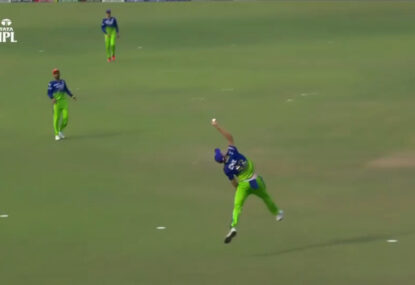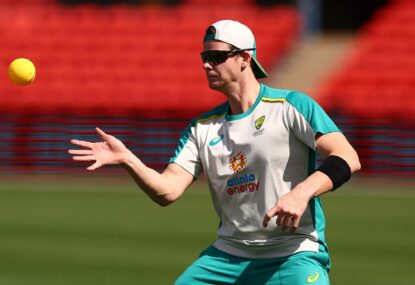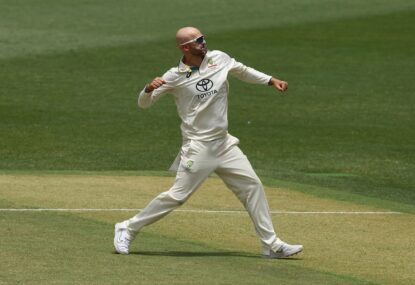The 2021 ICC World T20 is a few weeks away from starting and Australia are one of the 16 nations competing in the tournament.
With Australia aiming to win their first World T20, I wanted to look at some of Australia’s best and worst games in their World T20 history.
Australia versus Zimbabwe, Cape Town, 2007
In Australia’s first ever T20 World Cup game, they faced Zimbabwe in what many predicted would be a convincing win for the Aussies. Batting first, Australia were strangled by quality bowling and fielding. Despite boasting a destructive top four with the likes of Adam Gilchrist, Matthew Hayden, Ricky Ponting and Michael Hussey, Australia were struggling at 4-48 in the ninth over. Cameos from Andrew Symonds (33 off 25) and Brad Hodge (35* off 22) helped Australia post 9-138.
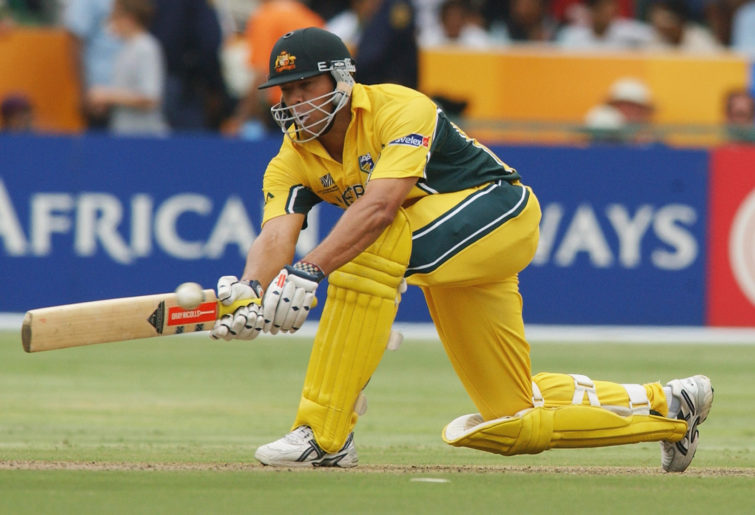
(Photo by Nick Laham/Getty Images)
A quick-fire knock from Vusi Sibanda (23 off 15) gave Zimbabwe a fast start, but the Aussie bowlers pegged things back as Zimbabwe slumped to 4-70 in the 11th over. Australia’s bowlers fought hard and kept Australia in the game as Zimbabwe needed 12 runs off the final over. But the well set Brendan Taylor (60* off 45) hit a boundary in the first ball of the over before his pads ensured Zimbabwe got four leg byes en route to winning by five wickets in the final over with a ball to spare.
Australia versus Sri Lanka, Cape Town, 2007
The stakes were high in this Super 8 clash, as the winner would progress to the semi-final. And from the beginning, Australia showed their ruthlessness. Electing to field first, Sri Lanka struggled to ever get going with the bat, slumping to 7-43 in the tenth over. Jehan Mubarak (28 off 26) and Chaminda Vaas (21 off 28) ensured Sri Lanka were not wholeheartedly embarrassed as the Sri Lankans were bowled out for 101 in the 20th over.
Australia showed no mercy with the bat, chasing down 102 with all wickets intact in the 11th over. Throughout the tournament, this was the first ten-wicket victory in a run chase. The pressure was heavily on Australia, yet this was their most complete performance en route to qualifying for the semi-finals before India beat the Aussies in the semi-final.
Australia versus Sri Lanka, the Oval, London, 2009
After losing to the West Indies, Australia had to beat Sri Lanka or be eliminated in the group stages of the 2009 edition of the World T20. From the beginning, the stars were not aligned Australia’s way. Lasith Malinga and Ajantha Mendis ran riot with the ball as Australia fell to 6-94 in the 15th over. Some respite from Brett Lee (15 off five) and Mitchell Johnson (28* off 13) pushed Australia’s score to 9-159. Could Australia’s bowlers put up a successful rescue mission on a flat Oval track?

(Photo by Phil Cole/PA Images via Getty Images)
The answer was no. Half centuries from Tillakaratne Dilshan (53 off 32) and Kumar Sangakkara (55* off 42) alongside a quick-fire 21 from Jehan Mubarak saw Sri Lanka chase down 160 in 19 overs with six wickets in hand. Australia looked lost in the 2009 ICC World T20 and the performance against Sri Lanka was arguably the worst performance they had in T20 World Cup history until then.
Australia versus Pakistan, Gros Islet, 2010
The stakes were high in this match. After all, it was a semi-final with the winner set to play England in the final. Batting first, Pakistan muscled the Australian attack all over the park. Brothers Kamran (50 off 34) and Umar Akmal (56* off 35) led the charge with the bat, with Pakistan posting 6-191. With the bowling attack the Pakistanis possessed, it would require Australia to bat out of their skins to chase down 192.
The Aussies attacked from ball one, but Pakistan kept on pegging things back with wickets. Cameron White (43 off 31) was threatening to take the game away from Pakistan but his dismissal in the 17th over meant Australia needed 53 off 21 balls with only Michael Hussey left as the remaining frontline batsman. Steve Smith was stumped in the 18th over and with Australia needing 48 off 17, the game was all but over.

(Photo by Hamish Blair/Getty Images)
But Hussey had other ideas. Chipping in with boundaries in the 18th and 19th over, Australia required 18 off the final over with Mitchell Johnson on strike and Saeed Ajmal bowling the final over. Conceding a single first ball, Australia’s hopes were left on Hussey to take Australia home. And boy, did he deliver. Hussey went six, six, four, six as Australia won by three wickets with a ball to spare. Scoring 60 off 24 in a crunch game, Hussey’s knock against the defending champions is one of the best T20 World Cup innings and helped Australia achieve their best ever T20 World Cup victory.
Australia versus Pakistan, Colombo, 2012
Having won both of their Super 8 games, Australia needed to lose by a certain margin to ensure they would directly qualify for the semi-finals. Winning the toss on a slow wicket, Australia surprisingly chose to bowl first. At first, the decision seemed to pay off as Pakistan were 2-29 in the sixth over. But a fighting 50 from Nasir Jamshedpur (55 off 46) and contributions from Kamran Akmal (32 off 26) and Abdul Razzaq (22 off 17) saw Pakistan post 6-149.

(Photo by Donall Farmer/PA Images via Getty Images)
If Australia scored 112 or more, they would qualify directly to the semi-finals regardless of how India versus South Africa panned out.
Pakistan attacked Australia with spin from ball one and unsurprisingly, Australia struggled to get out of a rut, limping to 2-21 after the power play. Michael Hussey (54* off 47) held the Aussie innings together, but Australia never got going. Despite a poor showing with the bat, they reached 7-117 after 20 overs and directly qualify for the semi-finals.
However, this was nowhere near a good enough performance. Despite the pitch turning, Australia only bowled eight overs of spin compared to 18 overs of spin by Pakistan. With the bat, Australia looked lost against spin and that did not bode well for a semi-final against the West Indies.
Australia versus West Indies, Colombo, 2012
Having beaten the West Indies in the group stages, Australia were quietly confident of beating the West Indies in the semi-final. Despite having the West Indies 2-57 in the eighth over, Australia soon started to lose the plot with the ball. Dwayne Bravo (37 off 31) and Chris Gayle (75* off 41) put on 83 runs for the third wicket before a 15-ball 38 from Kieron Pollard pushed the Windies’ total to 4-205.
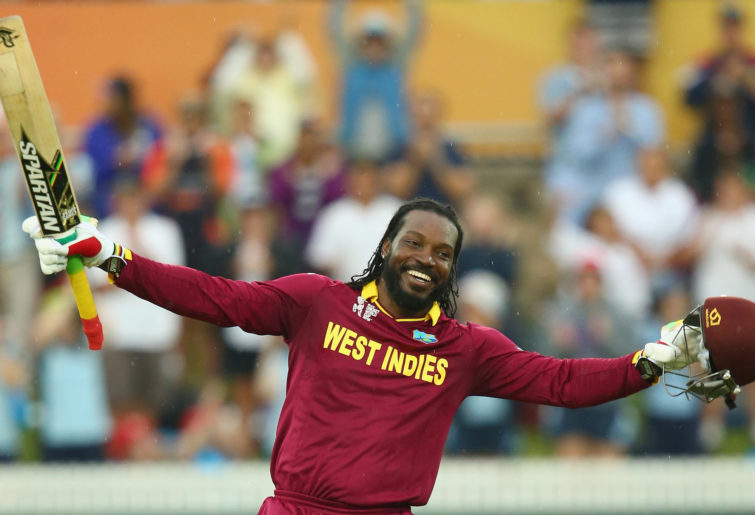
(Photo by Mark Kolbe/Getty Images)
Trinidad and Tobago duo Samuel Badree and Ravi Rampaul went nuts with the ball, with the Aussie batsmen having no answers as they fell to 6-43 in the eighth over. A 29-ball 63 from skipper George Bailey gave Australia some respite, but the Aussies were bowled out for 131 in the 17th over. While Australia did bowl poorly, the momentum had fully shifted towards the West Indies way after Bailey gave Xavier Doherty (1-48 off three overs) the 20th over instead of Brad Hogg (0-21 off three overs).
Doherty conceded 25 runs and the West Indies had already won psychologically by scoring over 200 in a knockout game. While it is not right to blame Doherty, Bailey was wrong to give him a third over considering how poorly he had bowled in the match. The batsmen faltered badly and never looked comfortable in the run chase of 205. Overall, Australia had saved their worst performance in the 2012 edition for a knockout game.
Australia versus India, Dhaka, 2014
In what was a must-win game for Australia to have a chance of making the semi-finals, they would have to beat favourites India. With Brad Hodge’s wizardry picking up a wicket in the opening over, India found themselves reeling at 4-66 in the 12th over. But some firepower from Yuvraj Singh (60 off 43) and 17 extras in total ensured India posted 7-159 on a sluggish Dhaka wicket.
Off spinner Ravi Ashwin ran riot with his off breaks and Australia had no idea how to handle him or the other Indian spinners in Ravi Jadeja and Amit Mishra. Actually scratch that. Does Australia know how to play anything that turns more than 0.05 degrees?
Ashwin’s figures of 4-11 led to the Aussies being bowled out for 86, with only three Aussie bats reaching double figures. While Australia performed poorly against Pakistan and West Indies earlier in the tournament, the loss to India was embarrassing and arguably the worst performance in their history of the T20 World Cup.





































































































